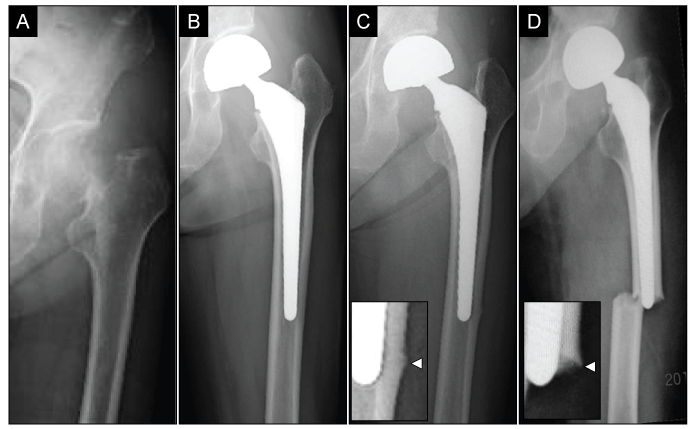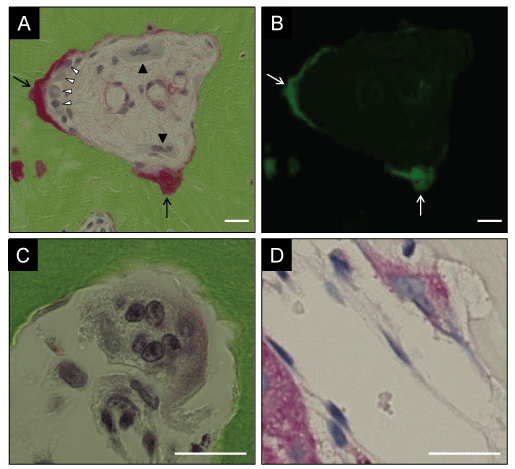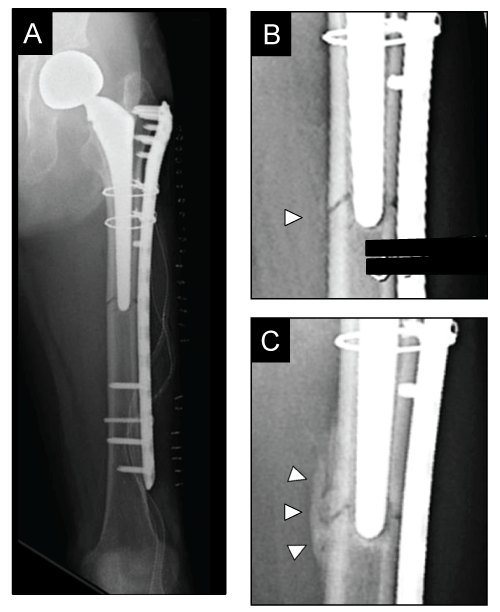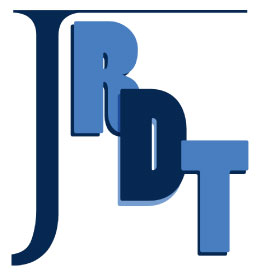Journal of Rheumatic Diseases and Treatment
Pathological Relationship of Osteomalacia at the Site of Atypical Periprosthetic Femoral Shaft Fracture after Typical Femoral Neck Fracture Occurred in the Patient with Rheumatoid Arthritis: A Case Report
Takanori Wakayama, Yoshitomo Saita*, Tomonori Baba, Hidetoshi Nojiri and Kazuo Kaneko
Department of Orthopaedics, Juntendo University School of Medicine, Japan
*Corresponding author: Yoshitomo Saita, Assistant Professor, Department of Orthopaedics, Juntendo University School of Medicine, Tokyo, Japan, 2-1-1, Hongo, Bunkyo-ku, Tokyo 113-8421, Japan, Tel: +81-3-3813-3111, Fax: +81-3-3813-3428, E-mail: ysaita@juntendo.ac.jp
J Rheum Dis Treat, JRDT-1-017, (Volume 1, Issue 3), Case Report; ISSN: 2469-5726
Received: June 23, 2015 | Accepted: July 13, 2015 | Published: July 17, 2015
Citation: Wakayama T, Saita Y, Baba T, Nojiri H, Kaneko K (2015) Pathological Relationship of Osteomalacia at the Site of Atypical Periprosthetic Femoral Shaft Fracture after Typical Femoral Neck Fracture Occurred in the Patient with Rheumatoid Arthritis: A Case Report. J Rheum Dis Treat 1:017. 10.23937/2469-5726/1510017
Copyright: © 2015 Wakayama T, et al. This is an open-access article distributed under the terms of the Creative Commons Attribution License, which permits unrestricted use, distribution, and reproduction in any medium, provided the original author and source are credited.
Abstract
We describe a patient who suffered an atypical periprosthetic femoral shaft fracture two years after surgical treatment for a typical osteoporotic femoral neck fracture. This patient had been suffering from rheumatoid arthritis (RA), steroid-induced diabetes, and steroid-induced osteoporosis, and had undergone long-term administration of glucocorticoids (GCs), bisphosphonates (BPs), and active vitamin D (aVD) analog. Prodromal pain and periprosthetic cortical stress reaction had occurred in the lateral cortex one month before she sustained the complete fracture. Histomorphometric analysis of a bone taken from just beneath the fracture site revealed the involvement of not severely suppressed bone turnover (SSBT) but osteomalacia. The serum concentration of 25-hydroxyvitamin D (25OHD) was low suggesting the status of vitamin D deficiency. Although periprosthetic fractures were excluded from the established definition of atypical femoral fractures (AFFs) of the American Society for Bone and Mineral Research (ASBMR), physicians should recognize that atraumatic atypical femoral fracture can occur even in a periprosthetic lesion during the postoperative management of osteoporosis-related fractures especially in patients with multiple comorbid conditions and vitamin D deficiency.
Keywords
Atypical femoral fracture (AFF), Bisphosphonate, Periprosthetic fracture, Osteomalacia, Severely suppressed bone turnover (SSBT)
Introduction
Bisphosphonates (BPs) are widely used in the treatment of osteoporosis and are highly effective at reducing the risk of osteoporosis-related fractures [1-3]. However, prolonged BP use has recently been considered to be related to the development of atypical femoral fractures (AFFs) [4-11]. Although some reports suggested that severely suppressed bone turnover (SSBT) is associated with the pathophysiology of AFFs [9,12,13], cortical hypertrophy has been observed as one of the radiological characteristics of AFFs, especially in patients with long-term BP treatment [14,15], suggesting that the new bone formation would occur on the cortical bone in patients with AFFs. There has been controversy among physicians regarding these observations linking SSBT and AFFs [16], and the pathophysiology of AFFs remains incompletely understood.
Surgical treatment such as bipolar hip arthroplasty (BHA), total hip arthroplasty (THA), and intramedullary nailing are frequently performed for the treatment of osteoporosis-related proximal femoral fractures in elderly patients. The prevalence of periprosthetic femoral fractures is 0.1% to 3.5% [17-21]. In contrast to the radiological features of AFFs represented by cortical hypertrophy [14], patients with typical osteoporosis-related periprosthetic fractures show a thinner cortex, spiral fracture, and comminuted fracture. Although the ASBMR established definition of AFF excludes periprosthetic fracture [14,21], AFFs can occur even in a periprosthetic lesion of the femur [22,23].
We report a patient who developed an atypical periprosthetic femoral shaft fracture. She had undergone BHA two years previously for the treatment of typical osteoporotic femoral neck fracture. Analyses of bone turnover markers before and after she sustained the complete fracture as well as histomorphometric evaluation of a bone specimen taken from femoral bone were performed.
Case Report
The case was a 68-year-old female who sustained a femoral neck fracture of her left hip (Figure 1A) and underwent BHA in December 2009. She had been suffering from rheumatoid arthritis (RA) for 31 years. She had been taking GCs (prednisolone, 6mg/day), BPs (risedronate, 2.5mg/day, 7 years), and active vitamin D analog (Alfacalcidol, 1μg/day, 7 years) for a long period. The bone mineral density measured by a dual-energy X-ray absorptiometry system was -2.5 in terms of the T-score. She had no symptoms in her left leg and no radiological findings of periprosthetic loosening were observed during the follow-up period from 2009 to 2010 (Figure 1B). She experienced groin pain and visited our hospital in January 2011. At this time, an anteroposterior pelvis radiograph showed a sign of "beaking" in the periprosthetic lesion of the lateral cortex (Figure 1C). Since we suspected this finding to be a cortical stress reaction related to the long-term BP treatment, we measured bone turnover markers (BTMs) (Table 1). This analysis revealed that neither bone resorption nor bone formation markers were severely suppressed (TRAP5b: 296mU/dl, BAP: 14.2μg/l, PINP: 21.4ng/ml), and serum level of calcium (9.5mg/dl) and phosphate (2.8mg/dl) were normal; however, a bone matrix-related marker, uncarboxylated osteocalcin (ucOC), was decreased below the limit of detection (ucOC: <0.38ng/ml). Although the serum concentration of 25OHD was low (25OHD: 13ng/ml, Table 1), the concentration of intact parathyroid hormone, calcium, and phosphorus were within normal range. Even though we carefully observed her clinical course, she sustained a spontaneous femoral fracture and was transferred to the emergency room the next month. A radiograph showed a periprosthetic complete transverse fracture and beaking of the lateral cortex was enlarged compared with that in the previous radiograph (Figure 1D). The facture occurred without trauma and the radiograph showed characteristic features of AFFs, such as transverse morphology, without evidence of comminution, and cortical thickening; therefore, this case met the requirements of both the ASBMR major features and the minor features of AFFs, except for being a periprosthetic fracture.

.
Figure 1: Atypical periprosthetic femoral fracture
Anteroposterior pelvic radiograph showing osteoporotic femoral neck fracture (A). Postoperative radiograph four months after underwent BHA (B). Panel C shows the pelvic radiograph one month before the atypical periprosthetic femoral fracture. White arrowhead in the magnified panel indicates the sign of beaking in lateral cortex. Panel D shows the atypical periprosthetic femoral fracture. White arrowhead indicates the enlarged beaking sign.
View Figure 1
![]()
Table 1: Transition of bone turnover markers
View Table 1
The patient received oral tetracycline (Achromycin V, 1000mg/day) on days 3-2 prior to surgery; informed consent was obtained prior to the start of the administration of tetracycline. Only single labeling of tetracycline could be performed as this patient had a high risk of complications, such as thromboembolism, aspiration pneumonitis, and disuse syndrome from long-term bed rest. Open reduction internal fixation was performed five days after the fracture and bone sample was obtained at the same time from the lateral cortex of the fracture site. The nomenclature, symbols, and units used in histomorphometric analyses are those recommended by the ASBMR Nomenclature Committee [24]. In the histomorphometric analysis of tartrate-resistant acid phosphatase (TRAP) staining of the decalcified section, TRAP-positive multinuclear osteoclasts as well as bone resorption fossa were observed in the bone envelope, and the osteoclast surface and the number of osteoclasts were not decreased (OC.S/BS: 2.8%, N.Oc/B.Pm (mm-1): 0.13) (Figure 2 and Table 2). In the analyses of fluorescence microscopy and Villanueva-Goldner staining of undecalcified section of bone embedded in methyl methacrylate, the number of osteoblasts was not decreased (N.Ob/B.Pm (mm-1): 1.6), tetracycline was labeled at the bone surface (sLS/BS: 32.7%), and osteoid surface was markedly increased (OS/BS: 36.4%) (Figure 2 and Table 2). These histomorphometric analyses indicated that the pathophysiology of AFF in this patient was associated with the condition of "osteomalacia" rather than SSBT.

.
Figure 2: Bone remodeling at the lateral cortex of atypical femoral fracture
Villanueva-Goldner-stained undecalcified section of bone (A and C). Mineralized bone is stained green and unmineralized bone osteoid stained red (black arrows); scale bar: 2μm. Panel B shows fluorescence micrograph of panel A. The green fluorescence of tetracycline labeling confirms the dynamic bone formation. White arrowheads indicate bone-forming osteoblasts. Black arrowheads indicate multinucleated osteoclasts. Bone resorbing multinucleated cells were observed in bone envelope (C). Tartaric acid-resistant acid phosphatase (TRAP) staining of the decalcified section (D) reveals TRAP-positive multinucleated osteoclasts (stained red).
View Figure 2
![]()
Table 2: The histomorphometric analysis of bone specimen obtained from lateral cortex of femora
View Table 2
Internal fixation was performed with a locking compression plate (LCP), a distal femur plate, and a cable system (Figure 3A). Risedronate was discontinued and teriparatide (20μg/day) was started after surgery; in addition, low-intensity pulsed ultrasound (LIPUS) was used in order to accelerate the bone union. Callus formation was observed two weeks after and bone union was confirmed four months after the surgery (Figure 3B,3C). Bone metabolism was improved after the administration of teriparatide, especially in terms of the markers of PINP and osteocalcin (Table 2).

.
Figure 3: Postoperative callus formation
Anteroposterior pelvis radiograph after the internal fixation (A). Radiograph of two weeks after the surgery (B) showing callus formation. White arrowheads indicate callus. Callus formation was gradually increased in sixteen weeks (C) post-surgery.
View Figure 3
Discussion
We described a case of an atypical periprosthetic femoral shaft fracture that occurred in a patient who had previously undergone BHA for the treatment of femoral neck fracture due to glucocorticoid-induced osteoporosis. Histomorphometric analysis of the fracture site revealed the pathophysiological involvement of osteomalacia. Treatment with rigid internal fixation and improvement of the bone metabolism using teriparatide successfully led to bone union.
Atypical femoral fracture was first described by Odvina et al. in 2005 [13]. This fracture was defined by the ASBMR taskforce by analyzing the published articles regarding AFFs in 2010 [14]. In 2013, the definition of AFFs was renewed by ASBMR task force and the periosteal stress reaction at the fracture site was changed from a minor to a major feature [25]. Although they defined major and minor features of AFFs, periprosthetic femoral fracture is excluded from this definition. Our case met the requirements of both the major and the minor features of AFF of the ASBMR, such as no trauma, transverse fracture, noncomminuted fracture, cortical hypertrophy, and prodromal symptoms (dull pain in the thigh), except that the fracture occurred in the periprosthetic lesion. Since these features were not consistent with typical osteoporotic periprosthetic fractures, we regarded this fracture as an atypical periprosthetic femoral fracture.
Cross et al. [22] reported a case of a bisphosphonate-induced periprosthetic femoral fracture [22]. They also warned physicians to note that AFFs do occur in periprosthetic lesions, especially in patients with prolonged BP use. In addition, Curtin et al. reported 3 patients with bisphosphonate-associated AFFs as an etiology of periprosthetic hip pain in THA patients [23]. Interestingly, two of these three patients suffered from rheumatoid arthritis and had undergone long-term treatment with GCs and BPs, similarly to our patient. Giusti et al. [8] identified 141 women with AFFs and revealed that the patients with atypical "subtrochanteric" femoral fracture had a higher number of chronic diseases [8]; furthermore, Girgis et al. [7] showed an increased risk of subtrochanteric fracture in patients administered GCs and BPs (odds ratio, 5.2) [7]. Therefore, it is likely that patients with prolonged use of BPs and GCs would become a high-risk population in terms of developing an atypical periprosthetic femoral fracture. Although periprosthetic fracture is excluded from the definition of AFFs, physicians should be aware of it and carefully manage these patients.
The vitamin D deficiency might be an important risk factor for AFFs [14]. Girgis et al. [7] reported that serum 25OHD level less than 16ng/mL was associated with an increased the risk of atypical subtrochanteric fractures (OR; 3.2) [7]. Furuya et al. [26] reported that the prevalence of vitamin D deficiency in Japanese patients with rheumatoid arthritis (RA) was high; the prevalence of vitamin D deficiency and severe deficiency were 71.8 and 11.5%, respectively [26]. In our patient, she had been suffering from RA, vitamin D deficiency existed prior to develop the fracture (Table 1). There were no clinical findings that supported the osteomalacia or calcium metabolism disorders in our patient, as it might be the effect of administration of a VD analog. However, the histological analyses showed the pathophysiology of osteomalacia at the site of fracture, suggesting that vitamin D deficiency could be partially involved in the development of atypical fracture in this patient.
Several theories have been proposed concerning the pathophysiology of AFFs. Odvina et al. [13] suggested that the pathophysiology of BP-induced SSBT is involved in the development of AFFs [13]. In addition, there have been several reported studies that investigated the dynamic bone remodeling in patients with AFFs; they also suggested the involvement of SSBT in the pathology of AFFs [27-29]. However, in these previous studies, transiliac bone biopsy was performed and they did not investigate the pathophysiology of fracture site, which is where the pathological reactions occur in AFFs. In the state of SSBT, which is defined as no or fewer bone-forming osteoblasts, it is likely that cortical hypertrophy would difficult to occur. On the other hand, Jamal described a patient with AFF who had undergone prolonged use of BPs, namely, for nine years [16]. Histomorphometric analysis of a bone biopsy at the "femoral cortex" after the use of tetracycline labeling revealed normal bone remodeling at the endosteal and cortical envelope, supporting the histomorphometric analysis results of our patient. In our case, newly formed osteoid surface was increased suggesting the link between AFFs and osteomalacia. In the analyses of BTMs in our patient at the fracture time, the serum level of osteocalcin was below the limits of detection (Table 1), on the other hand, other bone formation markers such as PINP and BAP were not severely decreased, suggesting that the maturation of osteoblast would be altered on the late stage of osteoblast differentiation. As a result, increase of osteoid volume and disorder of tissue repair process leads to bone fragility. Therefore, although prolonged BP and GCs use suppress overall bone remodeling and leads to the accumulation of microdamage, it is suggested that the cause of AFFs are not always related to the oversuppression of bone turnover, but would be related to alteration of the bone remodeling process and function of osteoblasts.
It is known that patients with AFFs are at high risk for delayed healing [14]. In this case, we supposed that the atypical periprosthetic fracture might have occurred as a result of a concentration of mechanical stress at the distal part of the femoral stem in the patient with deteriorated bone quality due to the long-term use of BPs, GCs, and the presence of RA. Some reports described that teriparatide, which has a bone anabolic effect, was effective for unhealed atypical fractures associated with chronic bisphosphonate use [6,28,30]. Therefore, we supposed that teriparatide therapy and LIPUS use could promote fracture healing in this patient, and we performed these treatments after the surgery in order to prevent delayed healing. Improvement of the BTMs was observed two weeks after the initiation of teriparatide, especially in terms of bone formation markers (Table 1). Callus formation was also confirmed on a radiograph from an early stage (Figure 3B). The ASBMR task force recommends that teriparatide should be considered in patients who suffer AFFs, particularly if there is little evidence of healing by 4 to 6 weeks after surgical intervention [14]. The American College of Rheumatology also recommends the use of teriparatide for glucocorticoid-induced bone loss [31]. Therefore, teriparatide is recommended for use in patients with AFFs who are taking BPs and GCs in the long term in order to prevent delayed union after surgical treatments.
In conclusion, we report a patient with atypical periprosthetic femoral shaft fracture. Histomorphometric analysis, including that of dynamic bone turnover, revealed the pathophysiology of osteomalacia in the fracture site. Rigid internal fixation and teriparatide successfully leads to bone union. Although periprosthetic femoral fractures are rare, it is estimated that a large proportion of elderly osteoporotic patients would undergo hip replacement against the background of an aging society, resulting in an increase of post-operative periprosthetic femoral fractures associated with long-term BP use. Therefore, when managing patients who have undergone surgery, physicians should consider the possibility that AFF could occur, even in a periprosthetic lesion, especially in patients who have risk factors to develop AFFs including vitamin D deficiency.
Acknowledgement
We thank orthopedic surgeons working in Juntendo University Hospital, for providing the clinical data and treatment courses of this patient. We thank Takako Ikegami and Tomomi Ikeda, Laboratory of Molecular and Biochemical Research, Research Support Center, Juntendo University Graduate School of Medicine, Tokyo, Japan, for technical assistance. We would like to thank Dr. Masashi Nagao and Dr. Muneaki Ishijima (Department of Orthopaedics, Juntendo University School of Medicine) for valuable suggestions concerning this report.
This work was not funded by any research and training grants. The authors declare no competing interests.
Authors' roles: Study design: TW, YS, and TB. Study conduct: TW, YS, and TB. Data collection: TW. Data analysis: TW and YS. Data interpretation: TW, YS, and TB. Drafting manuscript: TW, YS, and TB. Revising manuscript content: TW, YS, and TB. Approving final version of manuscript: TW, YS, TB, HN, and KK. TW and YS take responsibility for the integrity of the data analysis.
References
-
McClung MR, Geusens P, Miller PD, Zippel H, Bensen WG, et al. (2001) Effect of risedronate on the risk of hip fracture in elderly women. Hip Intervention Program Study Group. N Engl J Med 344: 333-340.
-
Boonen S, Klemes AB, Zhou X, Lindsay R (2010) Assessment of the relationship between age and the effect of risedronate treatment in women with postmenopausal osteoporosis: a pooled analysis of four studies. J Am Geriatr Soc 58: 658-663.
-
Cranney A, Tugwell P, Adachi J, Weaver B, Zytaruk N, et al. (2002) Meta-analyses of therapies for postmenopausal osteoporosis. III. Meta-analysis of risedronate for the treatment of postmenopausal osteoporosis. Endocr Rev 23: 517-523.
-
Abrahamsen B, Eiken P, Eastell R (2009) Subtrochanteric and diaphyseal femur fractures in patients treated with alendronate: a register-based national cohort study. J Bone Miner Res 24: 1095-1102.
-
Black DM, Kelly MP, Genant HK, Palermo L, Eastell R, et al. (2010) Bisphosphonates and fractures of the subtrochanteric or diaphyseal femur. N Engl J Med 362: 1761-1771.
-
Carvalho NN, Voss LA, Almeida MO, Salgado CL, Bandeira F (2011) Atypical femoral fractures during prolonged use of bisphosphonates: short-term responses to strontium ranelate and teriparatide. J Clin Endocrinol Metab 96: 2675-2680.
-
Girgis CM, Sher D, Seibel MJ (2010) Atypical femoral fractures and bisphosphonate use. N Engl J Med 362: 1848-1849.
-
Giusti A, Hamdy NA, Papapoulos SE (2010) Atypical fractures of the femur and bisphosphonate therapy: A systematic review of case/case series studies. Bone 47: 169-180.
-
Goh SK, Yang KY, Koh JS, Wong MK, Chua SY, et al. (2007) Subtrochanteric insufficiency fractures in patients on alendronate therapy: a caution. J Bone Joint Surg Br 89: 349-353.
-
Meier RP, Perneger TV, Stern R, Rizzoli R, Peter RE (2012) Increasing occurrence of atypical femoral fractures associated with bisphosphonate use. Arch Intern Med 172: 930-936.
-
Rizzoli R, Akesson K, Bouxsein M, Kanis JA, Napoli N, et al. (2011) Subtrochanteric fractures after long-term treatment with bisphosphonates: a European Society on Clinical and Economic Aspects of Osteoporosis and Osteoarthritis, and International Osteoporosis Foundation Working Group Report. Osteoporos Int 22: 373-390.
-
Neviaser AS, Lane JM, Lenart BA, Edobor-Osula F, Lorich DG (2008) Low-energy femoral shaft fractures associated with alendronate use. J Orthop Trauma 22: 346-350.
-
Odvina CV, Zerwekh JE, Rao DS, Maalouf N, Gottschalk FA, et al. (2005) Severely suppressed bone turnover: a potential complication of alendronate therapy. J Clin Endocrinol Metab 90: 1294-1301.
-
Shane E, Burr D, Ebeling PR, Abrahamsen B, Adler RA, et al. (2010) Atypical subtrochanteric and diaphyseal femoral fractures: report of a task force of the American Society for Bone and Mineral Research. J Bone Miner Res 25: 2267-2294.
-
Feldstein AC, Black D, Perrin N, Rosales AG, Friess D, et al. (2012) Incidence and demography of femur fractures with and without atypical features. J Bone Miner Res 27: 977-986.
-
Jamal SA, Dion N, Ste-Marie LG (2011) Atypical femoral fractures and bone turnover. N Engl J Med 365: 1261-1262.
-
Fredin HO, Lindberg H, Carlsson AS (1987) Femoral fracture following hip arthroplasty. Acta Orthop Scand 58: 20-22.
-
Garcia-Cimbrelo E, Munuera L, Gil-Garay E (1992) Femoral shaft fractures after cemented total hip arthroplasty. Int Orthop 16: 97-100.
-
Lewallen DG, Berry DJ (1998) Periprosthetic fracture of the femur after total hip arthroplasty: treatment and results to date. Instr Course Lect 47: 243-249.
-
Cook RE, Jenkins PJ, Walmsley PJ, Patton JT, Robinson CM (2008) Risk factors for periprosthetic fractures of the hip: a survivorship analysis. Clin Orthop Relat Res 466: 1652-1656.
-
Shane E, Burr D, Abrahamsen B, Adler RA, Brown TD, et al. (2014) Atypical subtrochanteric and diaphyseal femoral fractures: second report of a task force of the American Society for Bone and Mineral Research. J Bone Miner Res 29: 1-23.
-
Cross MB, Nam D, van der Meulen MC, Bostrom MP (2012) A rare case of a bisphosphonate-induced peri-prosthetic femoral fracture. J Bone Joint Surg Br 94: 994-997.
-
Curtin BM, Fehring TK (2011) Bisphosphonate fractures as a cause of painful total hip arthroplasty. Orthopedics 34: e939-944.
-
Parfitt AM, Drezner MK, Glorieux FH, Kanis JA, Malluche H, et al. (1987) Bone histomorphometry: standardization of nomenclature, symbols, and units. Report of the ASBMR Histomorphometry Nomenclature Committee. J Bone Miner Res 2: 595-610.
-
Shane E, Burr D, Abrahamsen B, Adler RA, Brown TD, et al. (2014) Atypical subtrochanteric and diaphyseal femoral fractures: second report of a task force of the American Society for Bone and Mineral Research. J Bone Miner Res 29: 1-23.
-
Furuya T, Hosoi T, Tanaka E, Nakajima A, Taniguchi A, et al. (2013) Prevalence of and factors associated with vitamin D deficiency in 4,793 Japanese patients with rheumatoid arthritis. Clin Rheumatol 32: 1081-1087.
-
Cheung RK, Leung KK, Lee KC, Chow TC (2007) Sequential non-traumatic femoral shaft fractures in a patient on long-term alendronate. Hong Kong Med J 13: 485-489.
-
Visekruna M, Wilson D, McKiernan FE (2008) Severely suppressed bone turnover and atypical skeletal fragility. J Clin Endocrinol Metab 93: 2948-2952.
-
Armamento-Villareal R, Napoli N, Diemer K, Watkins M, Civitelli R, et al. (2009) Bone turnover in bone biopsies of patients with low-energy cortical fractures receiving bisphosphonates: a case series. Calcif Tissue Int 85: 37-44.
-
Wernecke G, Namdari S, DiCarlo EF, Schneider R, Lane J (2008) Case report of spontaneous, nonspinal fractures in a multiple myeloma patient on long-term pamidronate and zoledronic acid. HSS J 4: 123-127.
-
Grossman JM, Gordon R, Ranganath VK, Deal C, Caplan L, et al. (2010) American College of Rheumatology 2010 recommendations for the prevention and treatment of glucocorticoid-induced osteoporosis. Arthritis Care Res (Hoboken) 62: 1515-1526.





